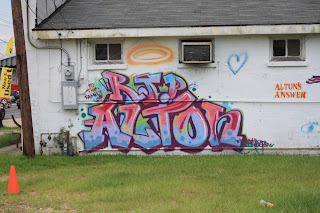Conversation with David LaMotte
Reflections by Alyssa Rossen
During our discussion with David LaMotte, we learned a lot
about often unnoticed barriers to successful communication and society’s
tendency to twist stories and history itself to fit the simplified hero
narrative, rather than the messier and less definable Movement narrative.
From
the beginning of our discussion, Mr. LaMotte made sure that we understood the
importance of defining some broader terms for the purpose of improving
communication. Some of these terms included words such as welcome, love, hope,
and optimism. Although we may assume that this would be a simple and
unnecessary task, a closer inspection reveals that there are many possible
correct definitions for each term listed, the variations of which could cause
misunderstandings and misinterpretations when discussing controversial or
important topics. This realization was truly eye-opening, as it means that due
to each individual’s unique experiences and outlook on life, every person
defines and interprets many words slightly differently. These differing
interpretations greatly increase the likelihood of disastrous misunderstandings
in critical discussions, if participants do not take the time to try to
understand the view points of each individual involved.
We
also learned that many stories throughout history may not be exactly as they
seem. Mr. LaMotte’s example was the well known day in 1955 when Rosa Parks
sparked the Montgomery Bus Boycott, greatly furthering the efforts of the Civil
Rights Movement, when she refused to give up her seat on the bus to a white
man. For most of us, this short summary seems to catch the important details
and may be all that we learned about Rosa Parks and the Boycott’s beginnings.
This version of that day’s events is formed into what is called a Hero
Narrative. We have an extraordinary individual who makes a split-second heroic
decision with far-reaching effects. It seems simple enough. The only problem is
that real life is rarely that simple. In reality, Rosa Parks had been working
behind the scenes in the Civil Rights Movement for years prior to her first
arrest and continued to do so afterwards along with many others.
One such
person is fellow Civil Rights activist, Jo Ann Robinson, who with the help of
two of her students, printed over 5,000 fliers for the boycott the night of
Rosa Parks’ arrest. Without the hard work of Ms. Robinson and many others who
had been waiting for the right time to begin the boycott for 18 months and
worked to keep it going with volunteer drivers and dispatchers after it’s
beginning. Although Rosa Parks’ actions were heroic and unplanned, it took many
others standing behind her to really make a huge difference. Without their
support, her story may have simply faded into the background of history like
that of Claudette Colvin, who had previously been arrested under similar
circumstances.
This more complete picture shows us that despite popular belief,
Rosa Parks’ story belongs under the Movement Narrative category, in which a lot
of people taking smaller steps in the same direction can have a large impact.
Instead of decreasing the heroism and bravery associated with Rosa Parks and
her actions, this more complete version actually increases them as it shows her
long term struggle towards equality. This movement narrative also shows that
the visible heroes are not the only ones who can make a difference; the only
thing required is ordinary people willing to come together and work for a cause
about which they are truly passionate. This means that, as Mr. LaMotte said,
anyone is able to change the world.




Comments
Post a Comment